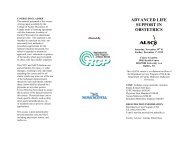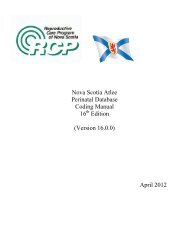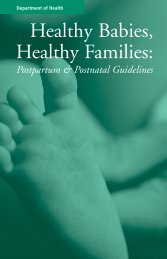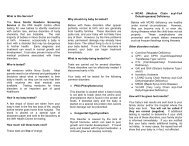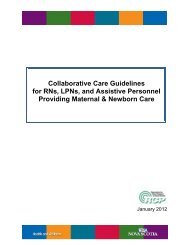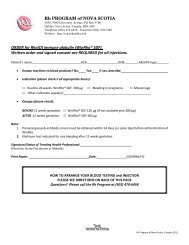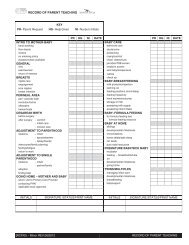Postpartum & Postnatal Guidelines - Reproductive Care Program of ...
Postpartum & Postnatal Guidelines - Reproductive Care Program of ...
Postpartum & Postnatal Guidelines - Reproductive Care Program of ...
Create successful ePaper yourself
Turn your PDF publications into a flip-book with our unique Google optimized e-Paper software.
POSTPARTUM AND POSTNATAL GUIDELINES<br />
screening tool could be used. 23 (<strong>Postpartum</strong> Depression Screening<br />
Tools - Attachment 12)<br />
3.6 Any contacts with the health care system can <strong>of</strong>fer an opportunity to<br />
assess psychosocial concerns identified in the prenatal period (as per<br />
3.1) and monitor ongoing emotional adjustment. Currently, these<br />
contacts occur at one to two weeks after birth (infant assessment), six<br />
weeks postpartum (maternal postpartum check), and at two, four, and<br />
six months <strong>of</strong> age (infant immunizations).<br />
3.7 The issue <strong>of</strong> family violence should be discussed with all women<br />
prenatally and postnatally. The National Clearinghouse on Family<br />
Violence recommends asking every woman about abuse prenatally and<br />
after birth; not only women whose situations raise suspicions <strong>of</strong><br />
abuse. 24 Information regarding community resources should be widely<br />
available (e.g. posters, printed information left in women's washrooms,<br />
etc.).<br />
4. Parent-child attachment/parenting<br />
Practices <strong>of</strong> health care providers, relevant policies and program<br />
guidelines should promote and support healthy parent-child<br />
attachment.<br />
The first five years are pivotal in a child's ability to learn and create, to love,<br />
to trust and to develop a strong sense <strong>of</strong> themselves. This process begins<br />
from the moment <strong>of</strong> birth through parent-child attachment. 25<br />
4.1 Preparation <strong>of</strong> mothers and families for parenting and the postpartum<br />
period should begin in the prenatal period.<br />
4.2 Parenting confidence can be enhanced by an understanding <strong>of</strong> infant<br />
behavior, infant cues and appropriate responses. 26 Practices that help<br />
support the attachment process include: direct skin-to-skin contact<br />
between mother/father and baby, supporting breastfeeding during the<br />
first hour after birth and keeping babies and parents together in<br />
23.<br />
24.<br />
25.<br />
Health Canada, Family-Centred Maternity and Newborn <strong>Care</strong>: National <strong>Guidelines</strong>.<br />
Health Canada, Population and Public Health Branch, The National Clearing House on Family Violence.<br />
F. Mustard & M. Norrie McCain, Early Years Study - Reversing the Real Brain Drain.<br />
26.<br />
K. Barnard & G. Sumner, Keys to <strong>Care</strong>givinG.<br />
24



